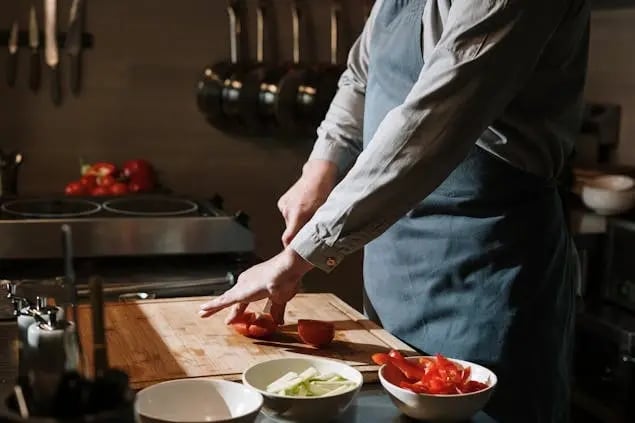An amazing service and a wide variety of food options are available. But have you ever thought about how these kitchens run smoothly without getting overwhelmed by the process? This blog will explain how ghost kitchens work.
The days of needing to visit a restaurant to enjoy a meal are long gone. Now, people can enjoy their favorite dishes with just a few taps on their phones, all from the comfort of home.
This is thanks to advancing technology and the growing popularity of the “order-in” culture. This shift has led to the rise of ghost kitchens worldwide.

Ghost Kitchens: A Quick Look at This Growing Global Trend
A ghost kitchen is simply a place where food is made and delivered, without a dine-in option for customers. It operates with just a well-equipped kitchen, a small staff, and a delivery-focused menu. Because of this setup, ghost kitchens avoid the big expenses that come with traditional restaurants, like a prime location, fancy decor, a large team, or dedicated parking.
Instead, ghost kitchens are listed on various food delivery platforms—both apps and websites—so customers can easily find and order from them. What’s interesting is that both new food entrepreneurs and well-established virtual restaurants run these kitchens.
Now that we’ve covered the basics of the ghost kitchen concept, let’s dive into how they actually work.
Step-by-Step Guide to How Ghost Kitchens Work
Ghost kitchens don’t have a physical storefront. The staff prepares meals from menus that are only available for delivery. It’s like a virtual restaurant, operating as a digital shop, with a small team focused on fulfilling online orders.
Unlike traditional restaurants, ghost kitchens don’t have to juggle tasks like serving customers or managing waiting areas. Their only focus is preparing high-quality food that’s designed for delivery. This makes the operations of ghost kitchens simple and easy to understand.
Let’s break it down step by step:
1. Order Placement
A customer places an order through any food delivery platform where your ghost kitchen is listed. To make this happen, you need a strong online presence and an appealing, easy-to-read menu.
2. Receiving Order Details
You get the order with all the important information, including any special requests or customizations from the customer.
3. Preparing the Order
You start cooking the fresh meal using the necessary ingredients and equipment, all within the promised time frame. While quality is key, speed is just as important—delays could lead to losing customers!
4. Packing the Order
Once the meal is ready, it’s time to pack it in the most hygienic, convenient, and safe way possible, while also making it look appealing. Quality packaging might cost more, but it’s crucial to ensure the food arrives in perfect condition, just as the customer expects.
5. Delivery
After packing, you mark the order as complete in the food delivery app or website. The delivery driver then comes to your ghost kitchen to pick it up and deliver it to the customer. Delivery services usually assign the closest driver to ensure the food reaches the customer quickly.
To make the most of these steps, you need to create an efficient workflow that fits your unique kitchen setup.
Technology Makes It Even Easier

Thanks to advancements in technology, running a ghost kitchen is now much simpler. There are many specialized POS (Point-of-Sale) systems for ghost and cloud kitchens, offering features that streamline daily operations.
Curious about what these features are? Here’s a quick list:
- A centralized system that collects and organizes all your orders in one place.
- Instant order assignment to ensure quick service.
- Tools to help manage inventory and track sales.
- Real-time reports and data to assess your business’s performance and plan for growth.
Ghost Kitchen Business Model
From a business perspective, ghost kitchens are highly cost-effective. You simply rent a space in a convenient location, get listed on food delivery apps like Postmates, and you’re set to start taking orders. The costs are much lower than traditional restaurants, and you can easily scale operations based on demand.
If you already own a traditional restaurant, you can branch out into ghost kitchens to extend your delivery range using the same space. This allows you to tap into new markets and try out new services without needing to make large extra investments.
One of the most common ghost kitchen business models is the shared ghost kitchen. In this setup, multiple ghost kitchens operate in the same facility, sharing the space and equipment. This cuts down overhead costs, leaving you with just rent, labor, and food expenses to cover.
Ghost Kitchens: The Future of Food Delivery?
.webp?width=635&height=424&name=robert-anasch-s04x1QTNnCA-unsplash%20(1).webp)
According to a Statista report, the global online food delivery business is expected to reach around $401.39 billion by 2025. The same study predicts the number of users will surpass 2.6 billion by then. With lower risks, easy upkeep, flexibility, minimal waste, and a small staff, it’s no wonder entrepreneurs, chefs, and investors are eager to get involved in ghost kitchens. This trend is only expected to keep growing in the coming years.
Concluding Thoughts
Ghost kitchens are proving to be a smart choice for anyone looking to enter the fast-growing food delivery market. They offer simple, efficient operations to meet the evolving needs of customers. The key challenge is picking the right menu and delivery options to stay competitive.
If you’re ready to start your own ghost kitchen and handle deliveries with contract drivers, we can help. At eLogii, we make sure your food gets delivered on time without the hassle of route planning. Our route optimization software takes care of planning, optimizing, proof of delivery, and dispatch. With eLogii, you can automate the entire delivery process. Why not give it a try?
